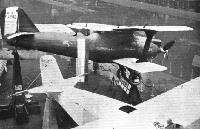Br.26T
Было построено четыре экземпляра Bre.26Т, в том числе два по лицензии фирмой CASA для гражданских заказчиков с возможностью перевозки до шести пассажиров. Два самолета в санитарном варианте - Bre.26TSbis - были поставлены ВВС Франции.
Показать полностьюShow all
Flight, December 1926
The Paris Aero Show 1926
BREGUET
THE Louis Breguet firm's exhibit at the Salon de l'Aeronautique will consist of three machines: (1) a Breguet 19 G.R. (500 h.p. Hispano-Suiza), holder of the world's straight-line distance record; (2) a Breguet 19 H. distant reconnaissance and bombing seaplane (450 h.p. Lorraine-Dietrich); and (3) a Breguet 26 T six-passenger transport aeroplane (420 h.p. Ghome-Rhone Jupiter).
<...>
The Breguet 26 T Transport Aeroplane.- The Breguet 26 T Transport Aeroplane is the first adaptation of the type 19 to the requirements of civil aviation. No changes have been made in the constructional methods, save that the central portion of the fuselage, which encloses the passenger cabin, is covered with plywood and that the top wing, instead of being mounted on a stream-lined cabane, is fixed flush with the roof of the cabin.
Although the 26 T retains unmistakable Breguet lines, the noteworthy depth and width of the fuselage somewhat detract from the beautiful streamlines of the type 19. But this is only natural, considering the large cubic capacity modern transport aeroplanes require for efficient operation.
The machine may be provided with two standard engine mountings: one for the 420 h.p. Jupiter air-cooled radial, and the other for the 450 h.p. Lorraine-Dietrich, or for the 450 h.p. Hispano-Suiza. Two long exhaust pipes lead the gases behind the cabin, thus greatly reducing the noise in flight.
The cabin seats six passengers, but there is room enough for fitting a seventh seat, if required. There are two luggage holds, one just behind the cabin and the other underneath the pilot's cockpit, which is situated in front of the wings, where the pilot enjoys maximum range of vision in all directions.
As this machine is still undergoing official tests, no performance figures are available. The wing area is 55 sq. m., the weight, loaded (with 420 h.p. Jupiter engine), 2,825 kg., and the estimated maximum speed 204 km.p.h.
This machine is incidentally considered as a transition type which will be replaced by type 28 T. This last-named aeroplane will have a span of 17 m. and a wing area of 57 sq. m.., and will carry eight passengers instead of six.
The following official performances are given for the Breguet 28 T transport aeroplane (420 h.p. Jupiter).- Maximum speed, sea level, 198 km.p.h.; climbing time, 2,000 m. in 15 mins., 3,000 m. in 28 mins.; ceiling, 4,500 m.; unstick run, 220 m.; range in still air, 800 km.
These performances were obtained with the following weight schedule :-
Weight, empty, 1,400 kg.; equipment (instruments, W/T, seats, &c), 104 kg.; crew (1), 85 kg.; petrol (500 litres), 360 kg.; oil (60 litres), 56 kg.; pay load (passengers and goods), 1,000 kg.; weight, loaded, 3,005 kg.
<...>
Most interesting of the Breguet exhibits was perhaps the new Breguet commercial aeroplane, the type XXVI T. This machine is of typical Breguet lines and the form of construction is similar to that made famous by the Type XIX. It is understood that the XXVI T. is only regarded as an experimental type, and that it will be replaced by a later model, the XXVIII T., which will have a slightly larger wing area and will carry eight passengers instead of the six for which accommodation is provided in the XXVI T. The tail plane of the XXVI T. looks somewhat inadequate in size, and it would seem likely that in the XXVIII T. a tail of considerably greater area will have to be fitted. The machine is so typically Breguet in its details that no further reference is required. A sketch, with the cabin wall removed, shows the arrangement of the passenger accommodation.
Показать полностьюShow all





